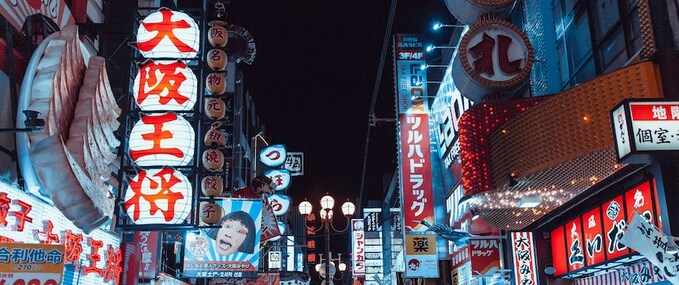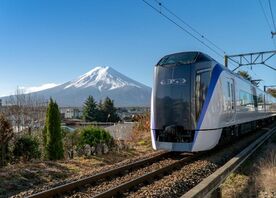The dazzling city of Osaka is a perfect base for day trips to other must-see locations in Japan. Find out more here.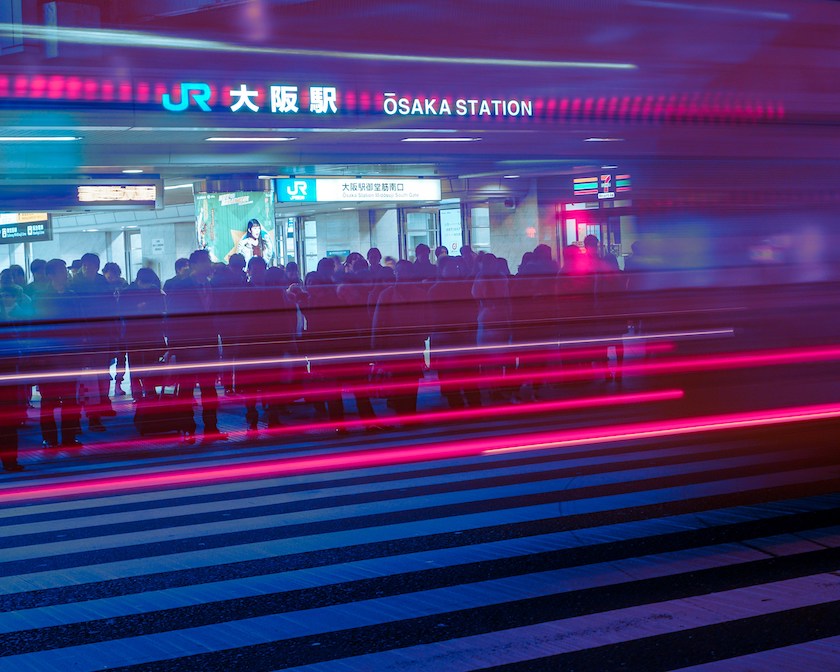
Intro
Osaka is out of this world! This vibrant, dazzling and futuristic mega city has a huge amount to offer visitors, from its famous neon cityscape to its reputation for outstanding food (earning it the nickname of Japan’s kitchen), to super cool neighbourhoods, shrines, temples, castles, nightlife, theme parks, aquariums, and much more. Of course, it’s always good to take a break from city life too and Osaka is an ideal base to explore the rest of the Kansai region, whether you’re craving the coast or countryside or just want to sample a different city. From sacred mountains and historic rural villages, coastal retreats, famous shrines, and art islands, Osaka has the best of Japan on its doorstep, especially if you have a JR Pass for unlimited travel on Japan’s domestic rail network. Japan’s trains are super fast, clean, safe, comfortable, and the perfect way to reach wherever you want to go across this unforgettable country. Ready to start exploring? Let’s get daytripping!
Eight of The Best Day Trips From Osaka
1. Kyoto
An obvious day trip from Osaka is another of Japan’s most famous and most visited cities - Kyoto, which is just 15 minutes away from Osaka on the Shinkansen. Known as the cultural heart of Japan, Kyoto is packed full of incredible history. The only downside is that Kyoto is so famous for its historic buildings, cultural treasures, shrines, and temples, that it is extremely popular with international visitors. It is, however, 100% worth it to see the beauty and history of Kyoto with your own eyes. Kyoto was the capital of Japan from the 8th Century to 1868 and the city embodies more than 1,000 years of history. Arguably the city’s most famous and historic districts are Gion, which is famous for its geisha district, and Pontocho, which was the birthplace of Kabuki. We’d recommend visiting both and have put together a guide to Kyoto After Dark: An Evening Stroll through Pontocho and Gion.
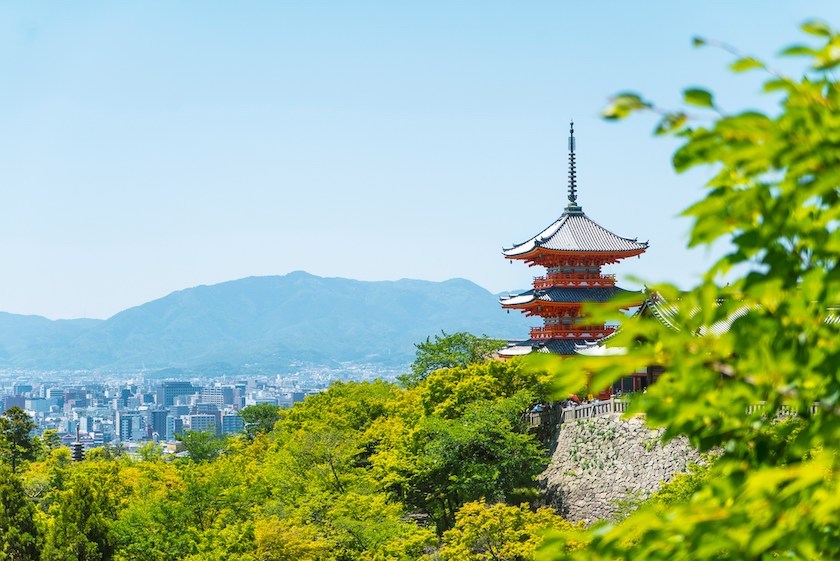
Kyoto is also home to some of Japan’s best shrines and temples. In fact, it boasts more than 1,600 temples which can make it hard to know where to start. Thankfully, we’ve done the hard work for you by putting together a list of our best temple recommendations when visiting Kyoto. Our list includes Kinkaku-ji Temple, Kiyomizudera Temple, Saiho-ji Temple, Kennin-ji Temple, Tofuku-ji Temple, Nanzen-ji Temple, Ginkaku-ji Temple, and Ryoan-ji Temple. Perhaps the most iconic temple in Kyoto is the “Golden Pavilion” of Kinkaku-ji - this iconic building has been the postcard of the city for many years. While Kinkaku-ji was founded in 1397, the temple had to be rebuilt in 1955 after a devastating fire. Despite that, it is one of many temples on this list that make up the Historic Monuments of Ancient Kyoto recognised by UNESCO as a World Heritage Site. Also vying for top spot among Kyoto’s temples is Kiyomizudera and its magnificent verandah. Kiyomizudera is found on Mt. Kiyomizu and overlooks the city. The original temple dates back to 798 although what you’ll see now is the version that was rebuilt in 1633. The temple’s name translates as “Pure Water Temple” and comes from the pure waters flowing over the Otowa Waterfall close by. But it’s really the immense wooden stage, said to have been built without a single nail, that is the star attraction here. For more temple recommendations read our blog post on the Best Buddhist Temples in Kyoto to Visit.
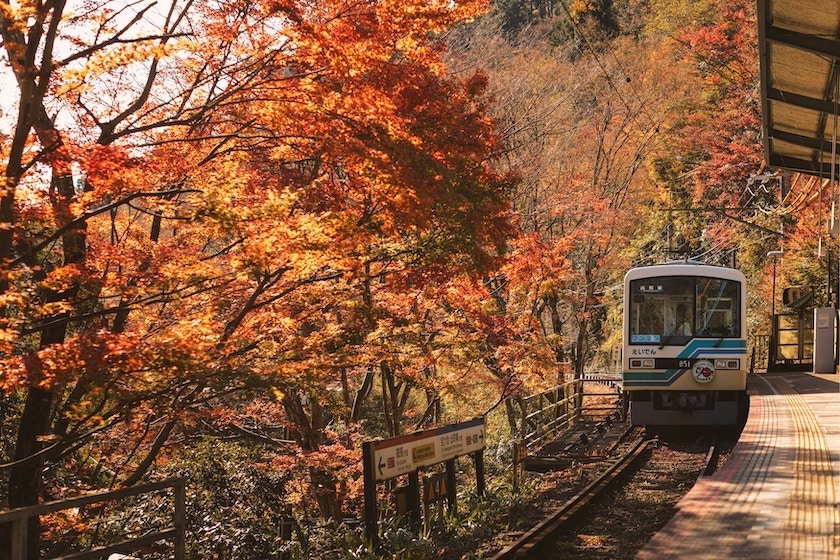
Kyoto is also famous for its Shinto shrines of course. The most famous and most important being Fushimi Inari Taisha, whose vermillion red torii gates were featured in the 2005 film ‘Memoirs of a Geisha’. Fushimi Inari Taisha was founded in 711, which makes it one of the oldest shrines in Kyoto. It was originally located on Inariyama hill, in the southwest of the city, before being relocated to its present and permanent home by the Hata family in 816. A century later, in 942, it was given the highest rank among Shinto shrines, and in 1499, after the beautiful and ornate main shrine structure was built, Japan designed Fushimi Inari Taisha as an Important Cultural Property. The origin of Fushimi Inari Taisha is steeped in legend. The story goes that a rice cake was fired into the air and turned into a swan which flew to the peak of Mt. Inari. Rice began to grow on the mountain top and the spot became the head shrine for Inari Okami, the Japanese god of rice, sake, and prosperity, and the patron of businesses, merchants and manufacturers. Today, thousands of people from across Japan, and millions of visitors from around the world, come to pray for fruitful harvests, business success, and other blessings. It is particularly popular for New Year prayers in Japan – one of the most important dates in the calendar. And of course, many international visitors come to see the famous Senbon Torii – the thousands of vermilion red gates in dense rows leading to the Torii gate hiking trail. Each one bears the name of a person or business carved in black who donated the gate to receive good luck and fortune. For more, read our Ultimate Guide to Kyoto’s Fushimi Inari Taisha shrine.
How to get from Osaka to Kyoto by train: The JR Tokaido Shikansen from Shin-Osaka Station to Kyoto Station takes just 15 minutes and is fully covered by the JR Pass while travelling on Hikari and Kodama trains.
2. Nara
Another excellent day trip from Osaka and just 40 minutes away by train is Nara - an area packed with history, wildlife, scenic views, temples, and shrines. Most of Nara’s historic attractions, as well as its famous free-roaming deer, are located within the 660 hectare Nara City Park, so it’s relatively small, which makes it easy to navigate. 
Start with a visit to the Heijo Palace site, which is a remnant from the time when Nara was the Capital of Japan and is now a World Heritage site. From here, go to the city centre for a visit to Kohfukuji and its three story pagoda. This is one of the most famous pagodas in Japan. Next, it is only a five-minute walk to the Nara National Museum, which houses a magnificent collection of Buddhist art and historic national treasures. After lunch head east through the deer park to the Kasuga Taisha Shrine, known for the many stone lanterns donated by worshippers, a profound atmosphere of calm can be felt. After visiting the shrine, take a walk through the forest and soak in the peaceful atmosphere surrounding the place. The last and most famous of our recommendations is Tōdai-ji - the crown jewel of Nara. This Buddhist temple complex houses the Great Buddha and its guardians. Even though it was completed in 752 A.D., it remains as one of the national masterworks of Japan.
How to get from Osaka to Nara by train: You can use both the JR Yamatoji Line, and the Kintetsu Nara Line to reach Nara by train from Osaka with a journey time of around 40-50 minutes.
3. Kobe
Just 1.5hrs from Osaka, and the home of the world-famous beef, Kobe is an attractive coastal city and a great day trip destination. 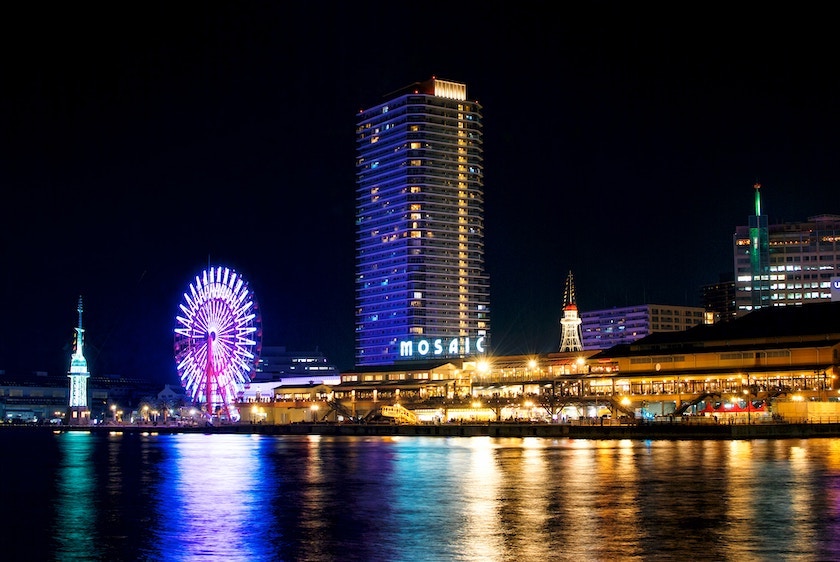
What’s so special about Kobe beef we hear you ask? Kobe beef is one of the most legendary types of beef in the world, both for its quality and its price. Of course, Kobe beef is more than just food, it’s a once-in-a-lifetime culinary experience and there’s nowhere better than Kobe itself to sample this delicious meat. While it can be served many different ways, arguably the best dishes to eat it are either in shabu shabu, which is a soup that has boiled meat, sukiyaki (hot pot), or teppanyaki, which is most people’s favourite. That is when the chef prepares, cooks, and serves the Kobe beef right in front of you. As we said, it is a truly special experience and Kobe is the place to go for this culinary adventure! Kobe isn’t just famous for food too. If you want to try one of Japan’s most famous traditional drinks then be sure to visit the city’s Hakutsuru Sake Brewery Museum. If that is not enough to convince you to visit Kobe, the city also boasts plenty of shopping opportunities, scenic views from the top of the nearby Mt. Rokko and its own Onsen Hot Springs Resort (Arima Onsen) within the city limits. And finally, Kobe (Ashiya district in particular) was also the childhood home of famous Japanese author Haruki Murakami!
How to get from Osaka to Kobe by train: Using a JR Pass, take either the shinkansen from Shin-Osaka Station to Shin-Kobe Station in just 15 minutes or for a more centrally located terminus, take the JR special rapid train from Osaka Station to Kobe's Sannomiya Station, which takes 20 minutes. Either way, it’s a quick journey and a perfect day-trip.
4. Koyasan and Kumano
The three grand shrines of the Kumano region are collectively known as the Kumano Sanzan temples. They consist of the Kumano Hongū Taisha, Kumano Nachi Taisha, and Kumano Hayatama Taisha, these Shinto shrines are incredibly sacred and a common pilgrimage destination. Hidden away in the forests near the southern end of the peninsula, the three shrines are connected by the ancient pilgrimage trails of the Kumano Kodo. This means that visiting the Kumano Sanzan isn’t just for those interested in Japan’s spiritual side, it’s also perfect if you want to experience the country’s rural side. You even have the chance to witness one of Japan’s most breathtaking waterfalls, Nachi-no-taki, when you stop at Nachi Taisha shrine. Amazingly, the Kumano Sanzan Temples and Ise Grand Shrine are not the only historic attractions in the Kii Peninsula. Alongside this, you’ll also find the historic and beautiful Buddhist monastery complex at Mt.Koya. Known as Kōyasan Shingon and located 800 metres above sea level, this is a unique and spiritual destination. One of the most important temples here is Danjo Garan, which has been a centre of religious teaching since the 9th century. If you’re lucky you might even spot some current students walking around in their yellow robes. Sights to see there include the recently-renovated Chūmon gate and the bright red Konpon Daitō pagoda.
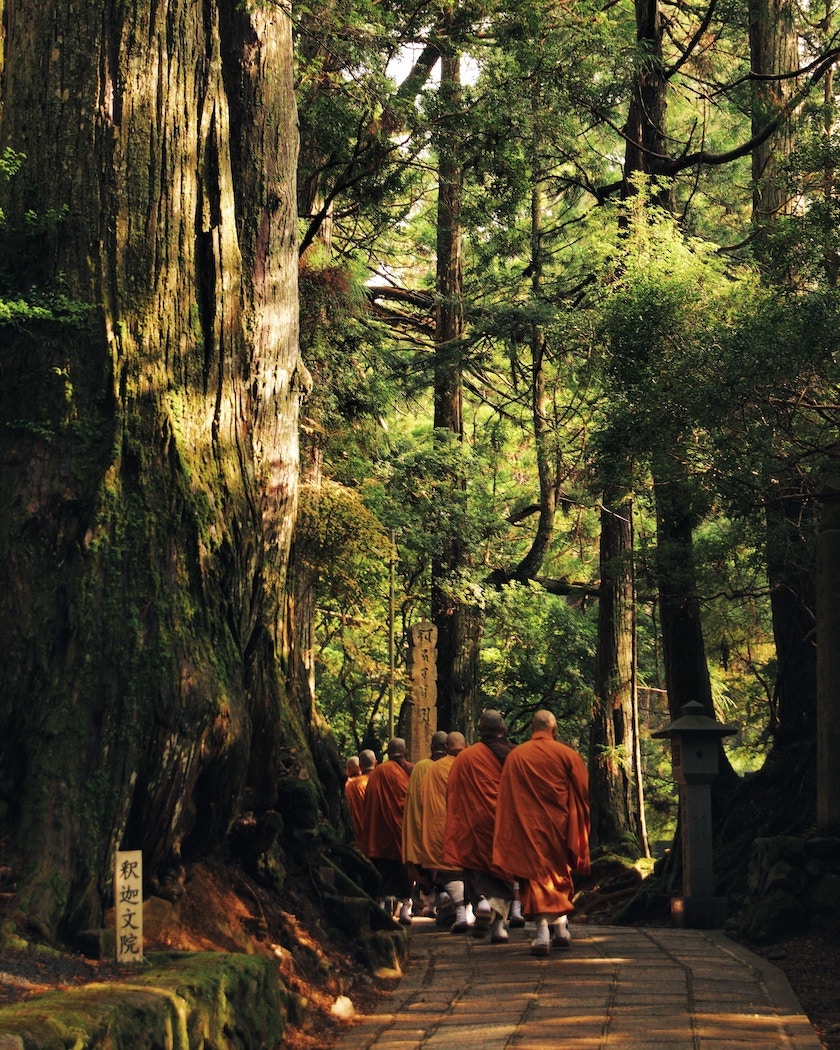
Another major temple is the Oku-no-in sanctuary, home to a cemetery of 200,000 tombs and the mausoleum of Kōbō Daishi, the founder of Shingon Buddhism. There in the forest you’ll find many stupas covered in moss and an air of tranquillity and reverence. Koya-san is also the beginning and end of the Shikoku Pilgrimage, which features 88 temples and shrines and can take three months to complete on foot. Even if you don’t have time for all 88, you can book a Shukubo (a ‘temple stay’) in Koya-san (which has more than 100 temples to choose from, many with their own onsen and zen gardens for maximum relaxation). Temples such as Eko-in and Muryoko-in are 1,000 years old and allow guests to meditate, practice calligraphy, take part in morning chanting and other rituals, and much more. It’s possible to stay for weeks to fully immerse yourself in the spiritual life. Read our Itinerary Tip: Koya-San for more information and travel recommendations.
How to get from Osaka to Koyasan by train: With a travel time of around two hours, this is one of the longer day-trip destinations, but it’s definitely worth it. You will need to set off from Nankai Namba Station in Osaka before getting off Gokurakubashi Station at the foot of Mount Koya.
5. Himeji Castle
One of Japan’s most beautiful and historic castles and just 50 minutes from Osaka on the Shinkansen, Himeji Castle is well worth a visit. Together with the castle garden, it’s a UNESCO World Heritage Site and national treasure of the highest rank. Because of its brilliant white exterior and resemblance to a heron taking flight, the castle bears the name “White Heron Castle” (Shirasagi-jō). 
The history and identity of Himeji city has long revolved around its castle, which has its origin in 1333, when the first fort on mount Himeji was built. A little over two centuries later in 1581, the fort was turned into a castle. In the following decades, Himeji castle was steadily expanded upon, creating an extensive castle complex with advanced defensive systems, which ended up being the largest castle in Japan. Unlike other castles in Japan, Himeji castle stood the test of time and was never destroyed by war or natural disaster, it survived fire bombs during WWII and the great Hanshin earthquake in 1995. In 2010 Himeji castle underwent a massive restoration project that took over 5 years and re-opened to the public in 2015. Today Himeji castle remains open to the public on most days and is an excellent example of prototypical Japanese castle architecture, feudal defence works and overall cultural significance.
How to get from Osaka to Himeji by train: Take the Hiraki shinkansen train from Shin-Osaka to Himeji Station. It’s a direct line and just 50 minutes away.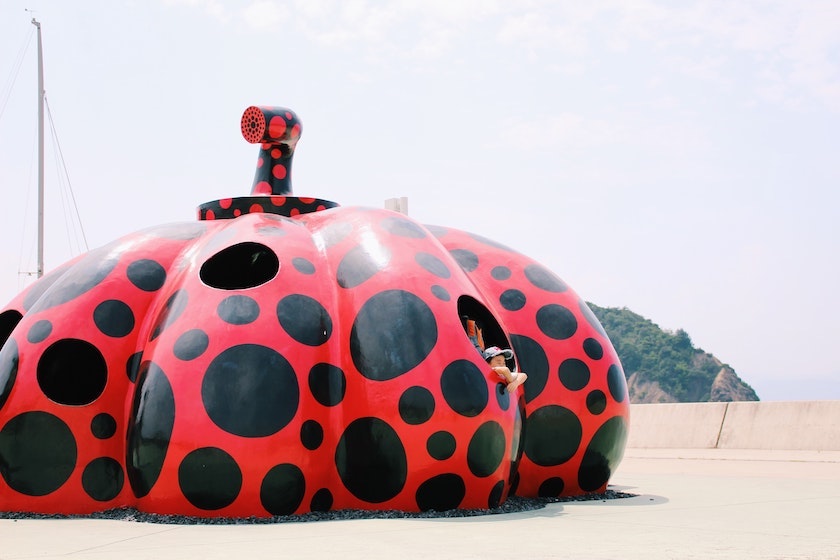
6. Naoshima Art Island
Famous for both its modern indoor and outdoor art, sandy beaches, stunning panoramic views and sunny weather, Naoshima art island makes for a great place to unwind during a timeout from Osaka and you can stay there too (if you want to do more than a day-trip). The island is home to the iconic Yellow Pumpkin by Yayoi Kusama (as well as the red variety pictured!). This is only the beginning of the collection of open air-sculptures and installations, including works by Dan Graham, Shinro Otake and Karel Appel. What about accommodation you ask? How about staying in an art museum? Benesse Art House is the most well known and perhaps most intriguing museum on Naoshima. Created in 1992, Benesse House is not just a museum but an upscale hotel as well. Staying guests can wander the exhibitions at night without being distracted by others. The art collection includes an international variety of work by Tadao Ando, George Rickey, Alberto Giacometti, Yasuo Kuniyoshi, Andy Warhol and others. Read our guide to Visiting Naoshima Art Island for a more detailed guide.
How to get from Osaka to Naoshima Art Island by train: Take the JR Sanyo Shinkansen Line to Okayama before changing to the JR Uno Line to Uno Station. It’s then just a short 20-minute ferry ride to the island) departing from opposite the train station).
7. Ise Jingu
Known as the spiritual home of the Japanese people, Ise Grand Shrine (or Ise Jingu) dates back almost 2,000 years and remains the most important and culturally significant shrine in all of Japan. If you’re fascinated by Japan’s spiritual history and the beauty of its shrines and temples, then Ise Grand Shrine should be at the very top of your list. The shrine is the home of the sun goddess Amaterasu, Japan’s supreme deity, and the location of the Sacred Mirror of the Emperor. One of the most fascinating facts about Ise Grand Shrine is that every 20 years, the inner and outer shrines as well as the Uji Bridge, are taken down and completely rebuilt in keeping with Shinto beliefs of rebirth and renewal. Ise Grand Shrine is not just spiritually and culturally important to Japan, it is also one of the most beautiful shrines you could ever hope to visit.
Ise Grand Shrine is known as Ise Jingu because ‘Jingu’ is the highest classification of Shinto shrines. Shinto is one of the two main spiritual belief systems in Japan, the other being Buddhism. As a basic rule, shrines like Ise Grand Shrine are related to Shinto, while temples belong to Buddhism. You can find out much more about both belief systems in our Spiritual Guide to Japan. Unlike Buddhism, Shinto originated in Japan and is deeply woven into the fabric of Japanese culture and history. The Shinto religion involves the worship of multiple gods or spirits known as kami, who are said to inhabit all things. Purity is the big focus of Shinto and there are different rituals that involve the cleansing of worshippers. Since Shinto has evolved organically and has no single origin or sacred text, practices vary depending on the kami and the region of Japan in which they take place.
How to get from Osaka to Ise Jingu by train: First, use the JR Tokaido Shinkansen from Shin-Osaka Station to travel to Nagoya then transfer to the "Mie" rapid train to Ise. The Rapid Mie train is one of the few options to access the prefecture of Mie, famous for the city of Toba, Ise Jingu temple, Ise Shima national park and of course, Mie itself. The Japan Rail Pass is valid on the Rapid Mie train, and as mentioned above, seat reservations can be made for free. There’s one catch though, as between Kawarada Station and Tsu Station the train travels on private railways operated by the Ise Railway. For this part, a 540 yen extra fare is required, which is not included in the pass. The fare is collected on board by the conductor, but can also be paid ahead of time at the ticket office. For more on this service, read our guide to The rapid Mie train from Nagoya to Ise and Toba.
8. Uji
Osaka’s rail connections are a passport to smaller towns and villages you may not have heard of or considered visiting before. Uji is a prime example and can be reached in around one hour from Osaka on the Shinkansen. Uji is mainly known for three things: World Heritage sites consisting of historic temples, shrines, tea and the Tale of Genji. Let’s start with Uji’s temples and shrines. Of the various temples in Uji, one you won’t want to miss is the Byodo-in Temple. This historic Buddhist temple dates back to 1053 and is one of two World Heritage sites in the city. Byodo-in Temple is celebrated for its elegant Phoenix Hall, a picture of which actually adorns one side of the 10¥ coin. Within this deceptively tall hall you’ll find a beautiful three-metre-tall statue of Buddha Amida. Aside from seeing the Phoenix Hall, make sure to visit the temple museum and see its assortment of artefacts. Next is Ujigami Shrine, the most important place of Shinto worship in Uji and another of Japan’s monuments recognised by UNESCO. The shrine isn’t particularly large but is shrouded in plenty of imperial history and is said to have been constructed by 1060. This makes it one of the oldest Shinto shrines in Japan.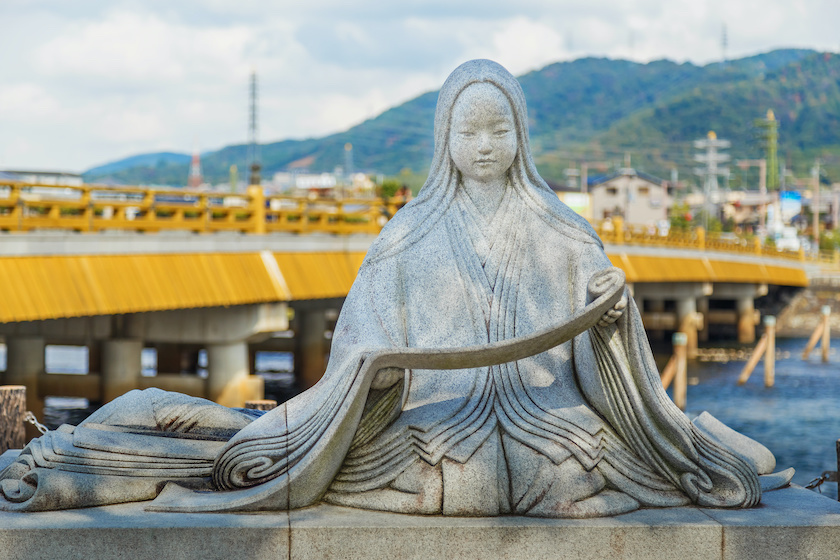
Next is an amazing literary fact that relates to Uji. Did you know that the oldest novel in the world is believed to be a Japanese tale from the 11th century? The novel is The Tale of Genji written by Murasaki Shikibu, a Japanese noblewoman, recounting a romance story of a prince and his adventures. Uji is the setting for the final ten chapters of the novel, a fact that the city is still quite proud of. No surprise then that there are multiple landmarks around Uji that commemorate that connection. One is a statue celebrating the novelist Murasaki Shikibu, just by the Uji Bridge across the river. But the city also hosts the Tale of Genji Museum dedicated to the story. Inside the museum exhibits show you what contemporary life was like during the period when the novel was set. All of this should make it clear that Uji is an essential stop if you’re going on a literary tour of Japan.
Drinking green tea is ever-present in life in Japan, being both the most popular beverage and part of many customs and traditions. Uji and its surrounding region has long had a reputation for its superior tea and it was one of the first places to properly adopt this habit from China. While in the city, the best way to experience tea in Uji is by visiting one of its riverside tea houses. You’ll also find Uji tea in most local restaurants and stores, while it’s common to find matcha-flavoured food like ice-cream for sale. There are even certain places, like the Taihoan tea house where you can experience a traditional Japanese tea ceremony first-hand.
Finally, as a side attraction, running through the city is the Uji River, one of the most beautiful spots in Uji. There’s plenty of nature on display as you look along the river to the surrounding hills blanketed in forest, which is especially pretty come spring or autumn. To really relax, take a boat ride on a local boat usually used for cormorant fishing.
How to get from Osaka to Uji by train: Using your Japan Rail Pass, travel on the JR Kyoto Line from Osaka to Kyoto before switching to the JR Nara Line from Kyoto to Uji. Total journey time is around an hour.
Bonus Recommendations
- As we mentioned above, the best way to visit one of Japan’s major cities and plan a number of day trips is using the Japan Rail for unlimited travel on the country’s domestic rail network. We’ve written a number of posts about the benefits of the JR Pass. You can find all of them on our blog, but here are a couple of suggestions as a starting point: The 10 Insider Tips For Using The JR Pass and The Seven Parks of the JR Pass That You May Not Know About.
- A bonus trip for daytrippers: Alongside the JRailPass for travelling from city to city, we also recommend prepaid travel cards for shorter journeys within Japan’s major cities. A prepaid travel card such as an ICOCA, PASMO or Suica card is essential for inner city public transport. Check out our Top 30 Tips for Using Japan’s Metros for advice and guidance on using the city’s subway network.
- Travelling from city to city, you’re going to want to stay connected so you can post photos of your adventures on social media and keep in touch with your friends and family back home. A Pocket Wifi device gives you unlimited internet on up to 10 devices wherever you go in Japan. It’s indispensable when travelling with children.
- If you’re visiting Japan for the first time and it seems daunting, why not use our special Meet and Greet Service to give you a helping hand on arrival? It’s like having an expert on Japan as a personal assistant for your holiday - perfect for visiting a major city like Osaka and taking day trips to multiple locations.
